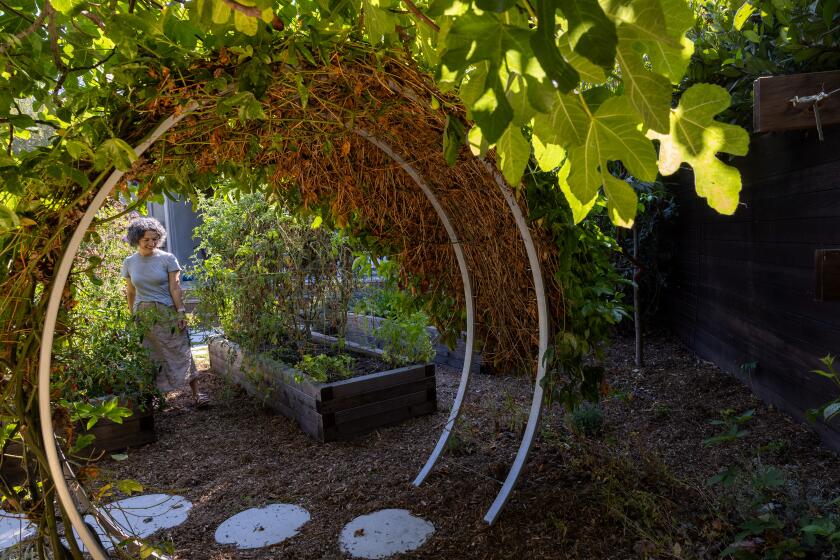Friends of Fronds Gather to Consider the Landscape
With so many palm trees soaring above the Southern California landscape, it seems a natural assumption that they’re indigenous. But it was settlers from Mexico who brought with them Washingtonia robusta, popularly called Mexican fan palm.
With their thin trunks, they soar and sway to heights of 60 feet to 100 feet at maturity and today are the most common in the region. These are the palm trees that have been captured on celluloid and for many people symbolize the sunny Southern California panorama.
It’s information such as this that is being discussed by members of the International Palm Society who, for the first time in the group’s 40-year-history, have congregated in Orange County to participate in a worldwide conference devoted to the love, lore, history and new developments of, you guessed it, palm trees.
More than 115 palm aficionados from Australia, New Zealand, England, Europe, Mexico, South America, Asia and the United States have been at the Hyatt Newporter for the weeklong conference, which ends today.
“We convene every two years, usually in the tropics, to exchange information, tour palm collections and swap seeds,” said Ralph Velez, a director of the International Palm Society and a past president and director of the local Southern California chapter of the society.
“Our last meeting was in Venezuela. In 1998, we’ll convene in Thailand.”
Botanists, scientists, hobbyists and professional palm growers have spent the week attending educational sessions, discussing discoveries and techniques for growing and sharing valuable seeds of rare varieties.
Highlights also included tours to view notable palm collections at Lotusland in Santa Barbara, the Huntington Botanical Gardens in San Marino, the Los Angeles State and County Arboretum in Arcadia and Quail Gardens in Encinitas.
In Orange County, they viewed the highly regarded collection at the Hyatt Newporter, designed by society member Loran Whitelock of Los Angeles, whose private collection of cycads and palms was also included on the tours, and the noted outdoor collections at Crystal Court and South Coast Plaza, Costa Mesa.
Private landscapes of two county residents were also visited, including that of Velez, whose Westminster home is surrounded by 1,000 palms trees representing 400 palm species (there are about 3,000 varieties worldwide). Experts believe his is the largest private collection in California.
“I have 350 different palm plants growing in the ground, representing 230 different species,” said Velez, a retired teacher from Los Amigos High School in Garden Grove. “I’m growing the rest in containers and am experimenting with different varieties to determine which are suitable for Orange County.”
Lois Resten’s collection in Huntington Beach was also viewed by the group. Resten is a former director of the International Palm Society and has 150 palm trees at home.
“When I moved here from Chicago more than 30 years ago, I wanted to go tropical,” she recalled. “I quickly discovered that palm trees are fairly easy to grow and not as much trouble as many other trees and shrubs.”
Velez also had been a transplant to Orange County from a cold climate. When he moved to Westminster in 1962, he too valued the tropical landscape atmosphere evoked by palm trees. And although palm trees are synonymous with Southern California, he was puzzled that so few were used as municipal plantings in much of Orange County.
“In the ‘60s and ‘70s, landscape designers used a lot of pine, sycamore and liquidambar trees,” he said. “They told me they wanted an East Coast look, not the Hollywood look.”
*
Local Palm Society members have tried to change that, pointing out with pride that the past decade has been marked with numerous palm plantings in the county, the majority at malls and commercial sites.
Palms are becoming so popular as both decorative indoor plants and landscape specimens that even rare varieties can be found at some large, discount home-and-garden centers.
“I was astounded to see containers of majesty palms for sale at a local Home Depot,” Velez said. “The majesty palm was discovered less than a decade ago in Madagascar. It can be used indoors because it’s shade tolerant.”
Increasingly, new varieties of palm trees from Madagascar and New Caledonia, an island in the southwest Pacific, are being discovered and are prized by collectors.
Velez is among those excited about a variety newly discovered in New Caledonia, Dypsis leptocheilos.
“It has a very attractive trunk, with hues of turquoise and sky blue,” Velez said. “At the crown shaft, where the trunk ends and the fronds emerge, it has rust-colored fuzzy growth, which is why it’s called ‘teddy bear.’
“Palms from New Caledonia do very well here,” Velez added. “The only drawback is that they’re exasperatingly slow to grow. One learns to be very patient with palms.”
The only palm native to this region is Washingtonia filifera, which grows in canyons in Southern California’s desert regions.
Because most palm trees are native to tropical or subtropical regions, they are sensitive to frost. Varieties differ in their frost tolerance, and some, such as the queen palm (Syagrus romanzoffiana) can tolerate temperatures as low as 20 degrees.
In their immature stages, many varieties are shade tolerant, and this makes them useful as house or patio plants. Their growth also slows when they are kept in containers.
In landscapes, they’re particularly effective near swimming pools because they don’t drop leaves.
For information about the International Palm Society or the local chapter, contact Ralph Velez, (714) 775-6324.
More to Read
Sign up for Essential California
The most important California stories and recommendations in your inbox every morning.
You may occasionally receive promotional content from the Los Angeles Times.










